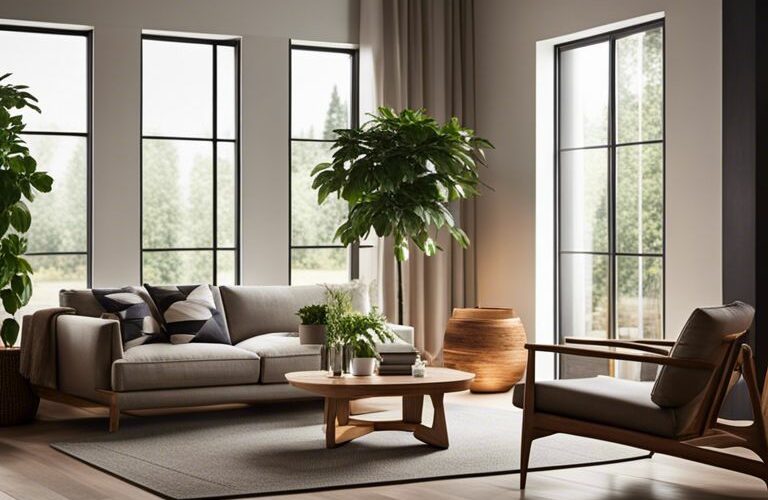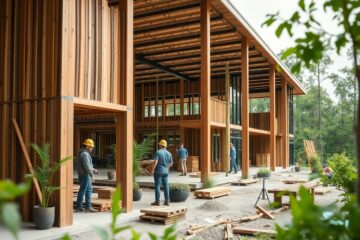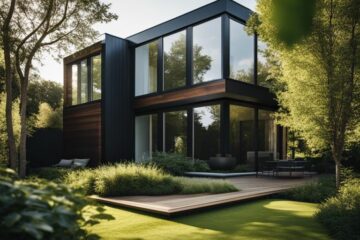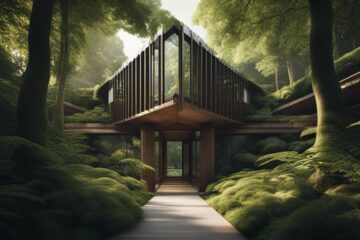Aesthetics play a crucial role in transforming the look and feel of your home. Wood is a timeless and versatile material that can add warmth, character, and charm to any space. In this blog post, we will explore the various ways in which wood can enhance the aesthetics of your home, from creating a cozy and inviting atmosphere to adding a touch of natural beauty and sophistication. Whether you’re considering wooden furniture, flooring, or accents, incorporating wood into your home decor can elevate its overall appeal and create a welcoming environment for you and your guests.
Table of Contents
Key Takeaways:
- Natural Beauty: Wood brings a warm and natural aesthetic to any home, creating a cozy and inviting atmosphere.
- Versatility: Wood can be used in various ways to enhance the aesthetics of your home, from flooring to furniture to decorative accents.
- Timeless Appeal: Wood has a classic and timeless appeal that can complement any style of decor, whether it’s modern, rustic, or traditional.
- Texture and Warmth: The unique textures and grains of different wood species add depth and character to a space, while also providing a sense of warmth.
- Sustainability: Opting for wood from responsibly managed sources adds a sustainable element to your home design, making it both aesthetically pleasing and environmentally friendly.
The Role of Wood in Interior Design
Assuming you are looking to enhance the aesthetics of your home, the incorporation of wood in interior design can play a significant role in achieving a warm and inviting atmosphere. Wood has been a popular choice for centuries due to its natural beauty, versatility, and durability. From furniture to flooring, wood can add a touch of elegance and timelessness to any space.
Emphasizing Natural Beauty and Warmth
To emphasize the natural beauty and warmth that wood brings to a room, consider using wood accents such as ceiling beams, trim work, and built-in cabinetry. These elements not only add visual interest but also create a sense of coziness. Additionally, incorporating wood furniture pieces like a dining table or a coffee table can bring a rustic charm to your living space.
Wood is a versatile material that can be stained, painted, or left natural to suit various design styles. Whether you prefer a modern aesthetic or a more traditional look, there is a type of wood finish to complement your taste. Wood also has the unique ability to age gracefully, developing a rich patina over time that adds character to your home.
Wood Types and Their Unique Characteristics
Warmth Wood comes in a variety of types, each with its own unique characteristics and aesthetic appeal. Oak, known for its strength and durability, is a popular choice for flooring and furniture. Maple, with its light color and smooth grain, is often used for cabinetry and millwork. Other popular wood types include cherry, walnut, and pine, each offering distinct colors and textures.
Emphasizing When choosing wood for your home, it is crucial to consider the hardness, grain pattern, and color of the wood to ensure it complements your interior design scheme. Recognizing the unique characteristics of each wood type will help you make an informed decision that aligns with your style preferences.
| Oak | Strength and durability, popular for flooring and furniture |
| Maple | Light color and smooth grain, used for cabinetry and millwork |
| Cherry | Distinct color and texture |
| Walnut | Rich color and grain |
| Pine | Softwood with a knotty appearance |
Practical Applications of Wood in Your Home
Structural Uses of Wood: Beams and Panels
Any well-constructed home relies on the structural integrity of its wooden beams and panels. Beams provide crucial support for the roof and upper floors, while panels help maintain the shape and stability of the building. Wooden beams can be visually appealing and add a touch of rustic charm to your living space, especially when left exposed.
For optimal performance, it’s important to choose high-quality wood for your structural elements. Hardwoods like oak and maple are popular choices due to their durability and strength. Regular maintenance, such as checking for rot or termites, is vital to ensure the longevity of these structural components.
Decorative Uses of Wood: Furniture and Accents
Wood can be utilized in various decorative ways in your home, from furniture pieces to smaller accents like trim and molding. Investing in quality wooden furniture not only adds warmth and elegance to your interiors but also guarantees longevity and durability. Wood accents, such as a wooden mantle or trim, can elevate the overall aesthetic of a room.
Wood furniture comes in a wide range of styles, from traditional to modern, allowing you to choose pieces that complement your existing decor seamlessly. When identifying wooden accents, consider the wood species and finish to ensure they harmonize with the rest of the room’s design elements.
Maintaining the Aesthetic of Wooden Elements
After carefully selecting and incorporating wooden elements into your home to enhance its aesthetics, it is crucial to maintain their beauty over time. Proper care and maintenance of wood can significantly extend the lifespan of these elements and keep them looking their best for years to come.
Best Practices for Wood Care and Maintenance
The key to preserving the aesthetic of wooden elements in your home is regular cleaning and maintenance. Dusting wooden surfaces frequently with a soft cloth can prevent the buildup of dirt and grime, which can dull the finish over time. Additionally, using a mild wood cleaner specifically designed for the type of wood in your home can help clean and nourish the wood without damaging it.
Another important aspect of wood care is protecting it from moisture and sunlight. Excessive exposure to water can cause wood to warp and rot, while prolonged exposure to sunlight can fade the color of the wood. Using curtains or blinds to shield wooden elements from direct sunlight and promptly cleaning up any spills or water leaks can help maintain the integrity of the wood.
Restoring and Refinishing to Preserve Beauty Over Time
Beauty can be restored to aged or damaged wooden elements through refinishing. Sanding down the surface of the wood to remove any imperfections and applying a fresh coat of stain or paint can breathe new life into worn-out wooden elements. This process not only enhances the appearance of the wood but also adds a protective layer that can help prolong its lifespan.
Practices such as refinishing should be done with caution, as incorrect techniques or harsh chemicals can damage the wood further. It is recommended to seek professional help for complex refinishing projects or if you are unsure about the best approach for a specific type of wood. By investing time and effort into restoring and refinishing wooden elements, you can preserve their beauty and ensure they remain a focal point of your home for years to come.
Innovative Design Ideas Using Wood
Incorporating Wood in Modern Design Schemes
Many modern designers are turning to wood to add warmth and a touch of nature to contemporary spaces. From sleek hardwood floors to minimalist wooden furniture, wood can seamlessly blend into modern design schemes. One innovative idea is to use wood as accent walls or ceiling panels to create a statement piece in a room. This approach adds texture and visual interest while still maintaining a clean and contemporary aesthetic.
Another way to incorporate wood in modern design is by choosing furniture pieces with clean lines and natural finishes. Opting for wood tables, chairs, or shelving units can introduce a sense of warmth and timelessness to a space, balancing out the sleekness of modern materials like glass and metal.
Sustainable and Eco-Friendly Wood Design Options
An increasing number of homeowners are seeking sustainable and eco-friendly design options, and wood is leading the way in this trend. Sustainable wood sources, such as reclaimed timber or bamboo, offer an environmentally conscious choice for designing and furnishing a home. These materials can help reduce the demand for new wood products, thus conserving natural forests and promoting environmental stewardship.
In addition to using sustainable wood, incorporating eco-friendly finishes and treatments can further enhance the environmental friendliness of wood design options. Choices such as non-toxic stains and varnishes or water-based sealants not only reduce environmental impact but also contribute to a healthier indoor air quality for occupants.
Summing up
Presently, we have explored the various ways in which wood can enhance the aesthetics of your home. From its natural warmth and beauty to its versatility in design and functionality, wood is a timeless choice that never goes out of style. By incorporating wood elements into your home, whether through furniture, flooring, or decorative accents, you can create a welcoming and inviting space that exudes charm and sophistication. With proper care and maintenance, wood can last for generations, adding value and character to your home. Consider the endless possibilities that wood can offer and unleash its potential to elevate the ambiance of your living space.
FAQ
Q: Why is wood a popular choice for enhancing the aesthetics of a home?
A: Wood is a popular choice for enhancing the aesthetics of a home due to its natural beauty, versatility, and timeless appeal. It can add warmth, texture, and character to any space.
Q: How can wood be incorporated into different areas of a home?
A: Wood can be incorporated into different areas of a home through flooring, furniture, cabinetry, wall paneling, ceiling beams, and decorative accents such as trim and molding.
Q: What are the benefits of using wood in home decor?
A: The benefits of using wood in home decor include its durability, sustainability, ease of maintenance, and ability to age gracefully over time, developing a unique patina.
Q: How can different types and finishes of wood affect the look of a home?
A: Different types of wood, such as oak, maple, cherry, or walnut, each have unique grain patterns and colors that can impact the overall look of a home. Finishes, such as stained, painted, or natural, can further enhance the aesthetic appeal of wood.
Q: What are some tips for effectively incorporating wood into home design?
A: Some tips for effectively incorporating wood into home design include mixing different wood tones for contrast, balancing wood with other materials like metal or glass, using wood in unexpected ways such as a feature wall or ceiling, and incorporating plants to complement the natural feel of wood.

Our contributing author is a passionate advocate for eco-friendly living and sustainability. With a background in eco-life, they are dedicated to inspiring and empowering individuals to adopt environmentally conscious lifestyles. Through insightful articles, they share practical tips, innovative solutions, and thought-provoking perspectives to promote a greener, more sustainable world. Join them on the journey towards eco-smart living and discover how small choices can make a big impact. 🌱









